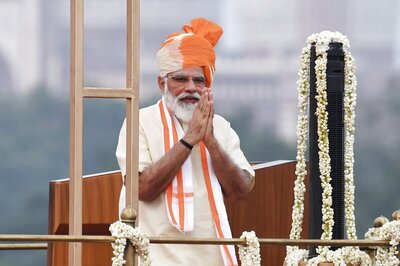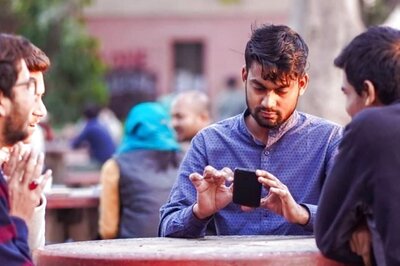
views
The good old emojis on your smartphone are so advanced now that we are now taking the whole issue of diversity very seriously. As we celebrate the World Emoji Day, Apple has confirmed that 59 new emojis will multiple skin colour options and other combinations will be rolling out for the iPhone, iPad, Mac and Apple Watch later this year. Smartphones running Google’s Android operating system are expected to follow the same path. Just the Holding Hands emoji, has as many as 75 possible combinations that you can then share with your friends on iMessage, WhatsApp, Telegram, Facebook Messenger, WeChat and pretty much any communication platform you can think of.
But how did we get here? The Unicode Consortium’s Emoji 12.0 package was finalized in February this year, and the focus is in giving an illustrative voice to human disabilities, gender, different races, food that popular in certain communities or parts of the world, representation from the animal kingdom, more activities and even attire that is popular in certain regions. Therefore, we have emojis such as a prosthetic arm and a leg, falafel and waffles, a saree, yawning emoji and an orangutan. It is all about inclusion and diversity, irrespective of gender.
Just last year, at the same time, Apple had confirmed that 70 new emojis were to be added for the iPhones and iPads, and the theme was about expanding representation—more faces, expressions and even the superhero community got their share of attention.
Emojis aren’t a recent thing, contrary to perception. They weren’t exactly conceptualized and implemented by millennials, even though they are the ones doing most of the communication with these visual fixtures in their phones. The emojis first appeared in pagers and phones in Japan in the late ‘90s, but then again, that was a time when Japan was showing us the way with smartphones. NTT Docomo first began experimenting with emojis in 1995, when they added a heart symbol to their pagers. These were designed by Japanese artist Shigetaka Kurita, and those original 176 emojis are now a part of the permanent collection at New York’s Museum of Modern Art.
Remember the beautiful flip phones that were a rage at one time? The Japanese had pretty much been using that design of phones for many years by then. And they showed us the way for emojis too. Through the mid-2000s, phone makers found one way or the other of implementing emojis in their phones. The big guns were also taking note. Apple had become active, and so had Google. The latter pushed to get emojis recognized by the Unicode Consortium, a non-profit corporation that is devoted to developing, maintaining, and promoting software internationalization standards. This also includes the Unicode Standard, used for emojis. At the same time, Apple engineers were pushing to get 625 new emoji characters adopted into the Unicode Standard.
iEmoji, a forum dedicated to this visual form of communication, makes a fine distinction between emojis and emoticons. While emoticons are “a group of characters to represent an emotion”, an emoji (Japanese for picture word) can be used to describe faces, activities, mood, weather, emotions or even places. If you are on a flight, you can simply reply to someone sending a message with an emoji of an aircraft, and they’ll know you are traveling. If someone in your team is falling behind a submission deadline, simply send a clock emoji instead of written words which could potentially be perceived unpleasantly.
In the meantime, more and more emoji characters arrived on phones. Eventually, they started replacing the written word in conversations (or at least as an alternative at times to typing out full sentences). It was only in 2011 that Apple integrated emojis into the on-screen keyboard app on the iPhone—till then, emojis were available in separate apps, which could be copy-pasted into a message and sent. Android did the same integration a couple of years later.
In 2014, the White House Council of Economic Advisors released a report on the education, debt, and healthcare status of millennials (defined by the report as “mostly in their mid-20s) with generous use of emojis to get their point across. For instance, the clapping emoji was used to depict education data, while an iPhone emoji signified the technology data and an ambulance emoji represented the section which talked about the healthcare options.
The emojis received the biggest dollop of attention in 2015, when the ‘Face with Tears of Joy’ emoji became the Oxford Dictionaries Word of the Year. The Oxford University Press had partnered with Swiftkey, a popular keyboard app for smartphones, and discovered that this particular emoji was the most popular with users globally.
Every year, the Unicode Consortium approves new emojis—the emoji language is now a full-fledged language. Along the way, there have been multiple attempts to ensure diversity is represented—a woman wearing a hijab, a man with a turban, a woman cradling a baby and a variety of skin tone options as well.
Emojis are taking on newer evolutions as we go along. There is the Animoji feature in the newest Apple iPhones, which uses the selfie cameras and sensors to register multiple points on your face to map the facial expressions, movement and voice. The result is an animation, with a hint of you. You can choose to be a monkey, a cat, a dog, a panda, a rabbit or even a pile of poop if that catches your fancy. Next up is Memoji, which lets you create an animated avatar of yourself—right down to the freckles on the skin, the hair style and colour, accessories such as sunglasses and more. These features have since been adopted by the likes of Xiaomi and Samsung, for their phones. Also Read | World Emoji Day: There are New Disability, Food, Animal and Saree Emojis Coming to Your iPhone



















Comments
0 comment